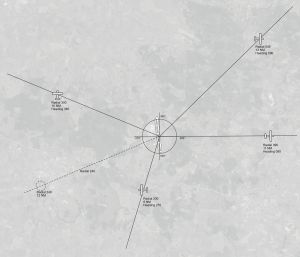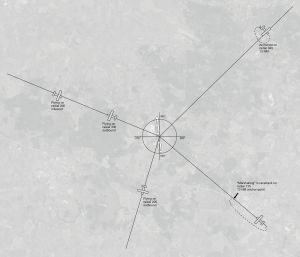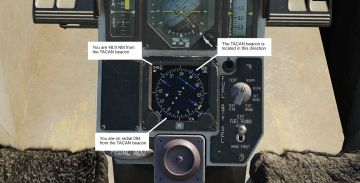Radials
Home >> Standard Operating Procedures >> Radials
Innehåll
What is a radial?
A radial is a compass bearing from a point. Usually from an airfield, TACAN station, VOR station or carrier.
Together with a range and altitude component, it is often used to describe where airplanes are located relative to an airfield, TACAN station, a carrier or bullseye. The first component of a bullseye call - the compass bearing from the bullseye - is a radial.
Important facts to note
The heading of an airplane has nothing to do with its radial, just like roll and pitch of the aircraft are unrelated to its position. Heading, pitch and roll will affect how the location of an aircraft changes over time, but is not needed to describe its current location relative to something else.
The heading of a carrier has nothing to do with radials relative to its TACAN station. The radial is a compass bearing from the carrier's location, regardless of whether the carrier is heading east or west etc.
To fly on a radial
When an aircraft is said to be "flying on a radial", it means that it remains on that radial. There are a couple of ways to fly a radial:
- Fly outbound on a radial
- Fly inbound on a radial
- Be anchored on a radial and distance - orbiting a certain point
- To marshal in a racetrack on a radial - meaning you are moving up and down a radial
When are radials used?
- During radio communications and navigation around airfields on arrival or departure - both for describing current positions, and for positioning flights
- During radio communications and navigation around carriers - especially CASE 3 operations
- Bullseye calls for describing flight locations relative to a predetermined "bullseye" location in the theatre of operations
Examples of radial usage in communications
Kutaisi, Indy9 marking your 080 (radial) for 35 miles angels 20
The flight Indy9 lets Kutaisi know that they are located 35 miles away in the 080 bearing from the Kutaisi airfield.
Picture: One group, bulls 350 (radial) for 50, angels 31, heading south
A group of aircraft is located roughly 50 miles north of the bullseye.
Indy91, Union Marshal, marshal on the 230 radial, 26 miles angels 11
The carrier marshal is telling Indy91 to position itself on the 230 radial 26 miles from the carrier.
Bonus reading: QDM and QDR
Understanding radials will get you far in aviation communications. There are also shorthand phrases for common scenarios. The most common of these are QDM and QDR:
QDM: Flying inbound on a radial, towards the reference location. For example, flying towards an airfield on radial 300 can be described as "QDM 300".
QDR: Flying outbound on a radial, away from the reference location. For example, flying away from an airfield on radial 300 can be described as "QDR 300".
How to read radials in various aircraft
Generally, you will have a navigation instrument that shows the bearing towards a waypoint or navigation beacon. The radial you are on is simply the reciprocal (opposite) of that bearing. Many navigation instruments (HSIs) will have a marker to help you read this opposite bearing.


